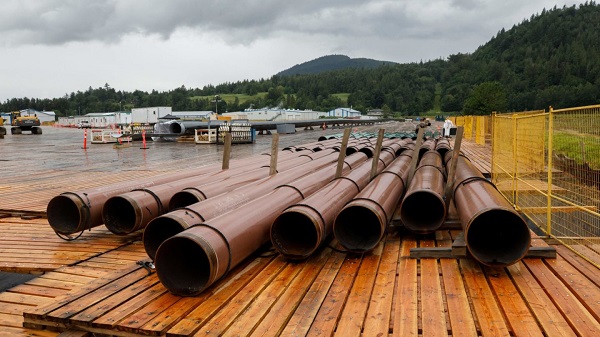Alberta
Tens of thousands of jobs set after Keystone XL makes deal with U.S. Unions

From TC Energy
Keystone XL Announces Project Labor Agreement with Four U.S. Unions
Creates Multi-Million Dollar Training Program for Renewable Energy Sector
TC Energy Corporation (TSX, NYSE: TRP) (TC Energy) announced today that Keystone XL has reached a project labor agreement (PLA) with four leading U.S. labor unions that will inject hundreds of millions of dollars in middle-class wages into the American economy, while ensuring this pipeline will be built by the highest-skilled and highest-trained workforce.
TC Energy is also working with labor to establish a unique Green Jobs Training Program to help union members acquire the specific skills needed to work in the developing renewable energy sector. The company will contribute approximately $10 million, recognizing the 10 million-plus hours anticipated to be worked on Keystone XL by union workers, to establish new training courses for current and future union members in North America.
“We are proud to partner with these union trades and craft workers to ensure this pipeline will be built by qualified professionals with specialized skills to the highest safety and quality standards,” said Richard Prior, President of Keystone XL. “We are especially proud of the new Green Jobs Training Program, which is an investment in thousands of current and future union workers.”
The four unions that are part of the PLA include the Laborers International Union of North America (LiUNA), the International Brotherhood of Teamsters, the International Union of Operating Engineers, and the United Association of Union Plumbers and Pipefitters. Each union is respected throughout the energy industry for their commitment to safety and quality.
“We’re proud to reach today’s agreement with TC Energy that will put UA members to work on this project, bringing safe and efficient energy to American families,” said Mark McManus, General President of the United Association of Union Plumbers and Pipefitters (UA). “This project will bring good paying jobs to our members, all while keeping energy costs low and delivering a boost to local communities and their economies. We’re ready to get to work.”
Project construction will support the creation of 42,000 family-sustaining jobs in the U.S, including more than 10,000 high-paying construction jobs that will be filled primarily by union workers. Keystone XL pipeline construction will generate $2 billion in earnings for U.S. workers, according to the 2014 Final Environmental Impact Statement done by the U.S. State Department.
“Unions working in the pipeline industry, like the Operating Engineers, pride themselves on achieving the highest level of technical training and safety to earn opportunities to build projects like Keystone XL,” said James T. Callahan, General President of the International Union of Operating Engineers. “When our members build and maintain pipelines, they are built right, built safe, and built to last. North America is in desperate need of more modern, safe and efficient energy infrastructure. Operating Engineers will continue to provide the most advanced training in the industry to ensure that these projects are built to the highest safety and environmental standards by the most skilled workforce possible.”
The agreement also underscores TC Energy’s commitment to hire as many local workers as possible, including Indigenous workers. Under the agreement, the unions will hire a tribal consultant to serve as a liaison, reaching out with job fairs and open houses to identify and support Indigenous members seeking to work on this project.
“The Keystone XL pipeline project will put thousands of Americans, including Teamsters, to work in good union jobs that will support working families,” said Jim Hoffa, Teamsters General President. “We believe in supporting projects which prioritize the creation of good jobs through much-needed infrastructure development.”
Keystone XL will create jobs and energy security in North America, by ensuring a reliable source of crude oil to the United States. Construction of Keystone XL will inject approximately $3.4 billion into the U.S. GDP. Once complete, Keystone XL will continue to contribute to the local economy, adding approximately $55 million in property taxes to local communities in Montana, South Dakota and Nebraska during the first year of operation.
For additional information on the project, visit Keystone-XL.com
Alberta
The case for expanding Canada’s energy exports

From the Canadian Energy Centre
For Canada, the path to a stronger economy — and stronger global influence — runs through energy.
That’s the view of David Detomasi, a professor at the Smith School of Business at Queen’s University.
Detomasi, author of Profits and Power: Navigating the Politics and Geopolitics of Oil, argues that there is a moral case for developing Canada’s energy, both for Canadians and the world.
CEC: What does being an energy superpower mean to you?
DD: It means Canada is strong enough to affect the system as a whole by its choices.
There is something really valuable about Canada’s — and Alberta’s — way of producing carbon energy that goes beyond just the monetary rewards.
CEC: You talk about the moral case for developing Canada’s energy. What do you mean?
DD: I think the default assumption in public rhetoric is that the environmental movement is the only voice speaking for the moral betterment of the world. That needs to be challenged.
That public rhetoric is that the act of cultivating a powerful, effective economic engine is somehow wrong or bad, and that efforts to create wealth are somehow morally tainted.
I think that’s dead wrong. Economic growth is morally good, and we should foster it.
Economic growth generates money, and you can’t do anything you want to do in social expenditures without that engine.
Economic growth is critical to doing all the other things we want to do as Canadians, like having a publicly funded health care system or providing transfer payments to less well-off provinces.
Over the last 10 years, many people in Canada came to equate moral leadership with getting off of oil and gas as quickly as possible. I think that is a mistake, and far too narrow.
Instead, I think moral leadership means you play that game, you play it well, and you do it in our interest, in the Canadian way.
We need a solid base of economic prosperity in this country first, and then we can help others.
CEC: Why is it important to expand Canada’s energy trade?
DD: Canada is, and has always been, a trading nation, because we’ve got a lot of geography and not that many people.
If we don’t trade what we have with the outside world, we aren’t going to be able to develop economically, because we don’t have the internal size and capacity.
Historically, most of that trade has been with the United States. Geography and history mean it will always be our primary trade partner.
But the United States clearly can be an unreliable partner. Free and open trade matters more to Canada than it does to the U.S. Indeed, a big chunk of the American people is skeptical of participating in a global trading system.
As the United States perhaps withdraws from the international trading and investment system, there’s room for Canada to reinforce it in places where we can use our resource advantages to build new, stronger relationships.
One of these is Europe, which still imports a lot of gas. We can also build positive relationships with the enormous emerging markets of China and India, both of whom want and will need enormous supplies of energy for many decades.
I would like to be able to offer partners the alternative option of buying Canadian energy so that they are less reliant on, say, Iranian or Russian energy.
Canada can also maybe eventually help the two billion people in the world currently without energy access.
CEC: What benefits could Canadians gain by becoming an energy superpower?
DD: The first and primary responsibility of our federal government is to look after Canada. At the end of the day, the goal is to improve Canada’s welfare and enhance its sovereignty.
More carbon energy development helps Canada. We have massive debt, an investment crisis and productivity problems that we’ve been talking about forever. Economic and job growth are weak.
Solving these will require profitable and productive industries. We don’t have so many economic strengths in this country that we can voluntarily ignore or constrain one of our biggest industries.
The economic benefits pay for things that make you stronger as a country.
They make you more resilient on the social welfare front and make increasing defence expenditures, which we sorely need, more affordable. It allows us to manage the debt that we’re running up, and supports deals for Canada’s Indigenous peoples.
CEC: Are there specific projects that you advocate for to make Canada an energy superpower?
DD: Canada’s energy needs egress, and getting it out to places other than the United States. That means more transport and port facilities to Canada’s coasts.
We also need domestic energy transport networks. People don’t know this, but a big chunk of Ontario’s oil supply runs through Michigan, posing a latent security risk to Ontario’s energy security.
We need to change the perception that pipelines are evil. There’s a spiderweb of them across the globe, and more are being built.
Building pipelines here, with Canadian technology and know-how, builds our competitiveness and enhances our sovereignty.
Economic growth enhances sovereignty and provides the resources to do other things. We should applaud and encourage it, and the carbon energy sector can lead the way.
Agriculture
Growing Alberta’s fresh food future

A new program funded by the Sustainable Canadian Agricultural Partnership will accelerate expansion in Alberta greenhouses and vertical farms.
Albertans want to keep their hard-earned money in the province and support producers by choosing locally grown, high-quality produce. The new three-year, $10-milllion Growing Greenhouses program aims to stimulate industry growth and provide fresh fruit and vegetables to Albertans throughout the year.
“Everything our ministry does is about ensuring Albertans have secure access to safe, high-quality food. We are continually working to build resilience and sustainability into our food production systems, increase opportunities for producers and processors, create jobs and feed Albertans. This new program will fund technologies that increase food production and improve energy efficiency.”
“Through this investment, we’re supporting Alberta’s growers and ensuring Canadians have access to fresh, locally-grown fruits and vegetables on grocery shelves year-round. This program strengthens local communities, drives innovation, and creates new opportunities for agricultural entrepreneurs, reinforcing Canada’s food system and economy.”
The Growing Greenhouses program supports the controlled environment agriculture sector with new construction or expansion improvements to existing greenhouses and vertical farms that produce food at a commercial scale. It also aligns with Alberta’s Buy Local initiative launched this year as consumers will be able to purchase more local produce all year-round.
The program was created in alignment with the needs identified by the greenhouse sector, with a goal to reduce seasonal import reliance entering fall, which increases fruit and vegetable prices.
“This program is a game-changer for Alberta’s greenhouse sector. By investing in expansion and innovation, we can grow more fresh produce year-round, reduce reliance on imports, and strengthen food security for Albertans. Our growers are ready to meet the demand with sustainable, locally grown vegetables and fruits, and this support ensures we can do so while creating new jobs and opportunities in communities across the province. We are very grateful to the Governments of Canada and Alberta for this investment in our sector and for working collaboratively with us.”
Sustainable Canadian Agricultural Partnership (Sustainable CAP)
Sustainable CAP is a five-year, $3.5-billion investment by federal, provincial and territorial governments to strengthen competitiveness, innovation and resiliency in Canada’s agriculture, agri-food and agri-based products sector. This includes $1 billion in federal programs and activities and $2.5 billion that is cost-shared 60 per cent federally and 40 per cent provincially/territorially for programs that are designed and delivered by provinces and territories.
Quick facts
- Alberta’s greenhouse sector ranks fourth in Canada:
- 195 greenhouses produce $145 million in produce and 60 per cent of them operate year-round.
- Greenhouse food production is growing by 6.2 per cent annually.
- Alberta imports $349 million in fresh produce annually.
- The program supports sector growth by investing in renewable and efficient energy systems, advanced lighting systems, energy-saving construction, and automation and robotics systems.
Related information
-

 espionage2 days ago
espionage2 days agoWestern Campuses Help Build China’s Digital Dragnet With U.S. Tax Funds, Study Warns
-

 Focal Points1 day ago
Focal Points1 day agoCommon Vaccines Linked to 38-50% Increased Risk of Dementia and Alzheimer’s
-

 Automotive1 day ago
Automotive1 day agoThe $50 Billion Question: EVs Never Delivered What Ottawa Promised
-

 Business2 days ago
Business2 days agoCanada invests $34 million in Chinese drones now considered to be ‘high security risks’
-

 Alberta11 hours ago
Alberta11 hours agoAlberta introducing three “all-season resort areas” to provide more summer activities in Alberta’s mountain parks
-

 Economy2 days ago
Economy2 days agoAffordable housing out of reach everywhere in Canada
-

 Business20 hours ago
Business20 hours agoStorm clouds of uncertainty as BC courts deal another blow to industry and investment
-

 Health1 day ago
Health1 day agoThe Data That Doesn’t Exist





